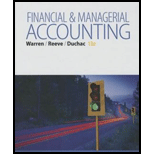
Bundle: Financial & Managerial Accounting, 13th + CengageNOWv2, 2 terms (12 months) Printed Access Card
13th Edition
ISBN: 9781305618909
Author: Carl Warren, James M. Reeve, Jonathan Duchac
Publisher: Cengage Learning
expand_more
expand_more
format_list_bulleted
Question
Chapter 3, Problem 3.10APE
(a)
To determine
Vertical analysis:
Vertical analysis is the method of financial statement analysis, and it is useful to evaluating a company’s performance and financial condition. Vertical analysis is helpful for analyzing the changes in the financial statements over the time, and comparing the each item on a financial statement with a total amount from the same statement. Financial statements are analyzed in the following manner:
- In vertical analysis of a
balance sheet , each asset item is stated as a percent of the total asset, and each liability and owner’s equity item is stated as a percent of total liabilities and owner’s equity. - In vertical analysis of an income statement, each item of revenue and expense is stated as a percent of total revenues of the business.
To prepare: The vertical analysis of Company H’s income statement.
(b)
To determine
To indicate: The favorable or an unfavorable trend of the vertical analysis.
Expert Solution & Answer
Want to see the full answer?
Check out a sample textbook solution
Students have asked these similar questions
Please explain the solution to this general accounting problem with accurate principles.
Steel Manufacturing uses a job order costing system. During one month, Steel purchased $188,000 of raw materials on credit; issued materials to the production of $215,000 of which $10,000 were indirect. Steel incurred a factory payroll of $159,000, of which $20,000 was indirect labor. Steel uses a predetermined overhead rate of 150% of direct labor cost. The total manufacturing costs added during the period are___.
Financial Accounting
Chapter 3 Solutions
Bundle: Financial & Managerial Accounting, 13th + CengageNOWv2, 2 terms (12 months) Printed Access Card
Ch. 3 - How are revenues and expenses reported on the...Ch. 3 - Is the matching concept related to (A) the cash...Ch. 3 - Why are adjusting entries needed at the end of an...Ch. 3 - What is the difference between adjusting entries...Ch. 3 - Identify the four different categories of...Ch. 3 - If the effect of the debit portion of an adjusting...Ch. 3 - If the effect of the credit portion of an...Ch. 3 - Does every adjusting entry have an effect on...Ch. 3 - Prob. 9DQCh. 3 - (A) Explain the purpose of the two accounts:...
Ch. 3 - Prob. 3.1APECh. 3 - Accounts requiring adjustment Indicate with a Yes...Ch. 3 - Type of adjustment Classify the following items as...Ch. 3 - Prob. 3.2BPECh. 3 - Adjustment for prepaid expense The supplies...Ch. 3 - Adjustment for prepaid expense The prepaid...Ch. 3 - Adjustment for unearned revenue The balance in the...Ch. 3 - Prob. 3.4BPECh. 3 - Prob. 3.5APECh. 3 - Adjustment for accrued revenues At the end of the...Ch. 3 - Adjustment for accrued expense We-Sell Realty Co....Ch. 3 - Adjustment for accrued expense Prospect Realty Co....Ch. 3 - Prob. 3.7APECh. 3 - Adjustment for depreciation The estimated amount...Ch. 3 - Effect of omitting adjustments For the year ending...Ch. 3 - Prob. 3.8BPECh. 3 - Prob. 3.9APECh. 3 - Effect of errors on adjusted trial balance For...Ch. 3 - Prob. 3.10APECh. 3 - Prob. 3.10BPECh. 3 - Classifying types of adjustments Classify the...Ch. 3 - Classifying adjusting entries The following...Ch. 3 - Prob. 3.3EXCh. 3 - Determining supplies purchased The supplies and...Ch. 3 - Effect of omitting adjusting entry At March 31,...Ch. 3 - Prob. 3.6EXCh. 3 - Adjusting entries for prepaid insurance The...Ch. 3 - Adjusting entries for unearned fees The balance in...Ch. 3 - Effect of omitting adjusting entry At the end of...Ch. 3 - Adjusting entry for accrued fees At the end of the...Ch. 3 - Prob. 3.11EXCh. 3 - Effect on omitting adjusting entry The adjusting...Ch. 3 - Prob. 3.13EXCh. 3 - Determining wages paid The wages payable and wages...Ch. 3 - Effect of omitting adjusting entry Accrued...Ch. 3 - Prob. 3.16EXCh. 3 - Prob. 3.17EXCh. 3 - Prob. 3.18EXCh. 3 - Prob. 3.19EXCh. 3 - Prob. 3.20EXCh. 3 - Prob. 3.21EXCh. 3 - Prob. 3.22EXCh. 3 - Effects of errors on financial statements The...Ch. 3 - Effects of errors on financial statements If the...Ch. 3 - Prob. 3.25EXCh. 3 - Prob. 3.26EXCh. 3 - Prob. 3.27EXCh. 3 - Prob. 3.28EXCh. 3 - Prob. 3.29EXCh. 3 - Prob. 3.1APRCh. 3 - Prob. 3.2APRCh. 3 - Prob. 3.3APRCh. 3 - Prob. 3.4APRCh. 3 - Adjusting entries and adjusted trial balances...Ch. 3 - Adjusting entries and errors At the end of April,...Ch. 3 - Prob. 3.1BPRCh. 3 - Adjusting entries Selected account balances before...Ch. 3 - Adjusting entries Crazy Mountain Outfitters Co.,...Ch. 3 - Prob. 3.4BPRCh. 3 - Adjusting entries and adjusted trial balances...Ch. 3 - Prob. 3.6BPRCh. 3 - The unadjusted trial balance that you prepared for...Ch. 3 - Prob. 3.1CPCh. 3 - Prob. 3.2CPCh. 3 - Prob. 3.3CP
Knowledge Booster
Learn more about
Need a deep-dive on the concept behind this application? Look no further. Learn more about this topic, accounting and related others by exploring similar questions and additional content below.Similar questions
arrow_back_ios
SEE MORE QUESTIONS
arrow_forward_ios
Recommended textbooks for you
 Financial AccountingAccountingISBN:9781305088436Author:Carl Warren, Jim Reeve, Jonathan DuchacPublisher:Cengage Learning
Financial AccountingAccountingISBN:9781305088436Author:Carl Warren, Jim Reeve, Jonathan DuchacPublisher:Cengage Learning Cornerstones of Financial AccountingAccountingISBN:9781337690881Author:Jay Rich, Jeff JonesPublisher:Cengage Learning
Cornerstones of Financial AccountingAccountingISBN:9781337690881Author:Jay Rich, Jeff JonesPublisher:Cengage Learning Managerial Accounting: The Cornerstone of Busines...AccountingISBN:9781337115773Author:Maryanne M. Mowen, Don R. Hansen, Dan L. HeitgerPublisher:Cengage Learning
Managerial Accounting: The Cornerstone of Busines...AccountingISBN:9781337115773Author:Maryanne M. Mowen, Don R. Hansen, Dan L. HeitgerPublisher:Cengage Learning Financial AccountingAccountingISBN:9781337272124Author:Carl Warren, James M. Reeve, Jonathan DuchacPublisher:Cengage Learning
Financial AccountingAccountingISBN:9781337272124Author:Carl Warren, James M. Reeve, Jonathan DuchacPublisher:Cengage Learning Financial Accounting: The Impact on Decision Make...AccountingISBN:9781305654174Author:Gary A. Porter, Curtis L. NortonPublisher:Cengage Learning
Financial Accounting: The Impact on Decision Make...AccountingISBN:9781305654174Author:Gary A. Porter, Curtis L. NortonPublisher:Cengage Learning

Financial Accounting
Accounting
ISBN:9781305088436
Author:Carl Warren, Jim Reeve, Jonathan Duchac
Publisher:Cengage Learning


Cornerstones of Financial Accounting
Accounting
ISBN:9781337690881
Author:Jay Rich, Jeff Jones
Publisher:Cengage Learning

Managerial Accounting: The Cornerstone of Busines...
Accounting
ISBN:9781337115773
Author:Maryanne M. Mowen, Don R. Hansen, Dan L. Heitger
Publisher:Cengage Learning

Financial Accounting
Accounting
ISBN:9781337272124
Author:Carl Warren, James M. Reeve, Jonathan Duchac
Publisher:Cengage Learning

Financial Accounting: The Impact on Decision Make...
Accounting
ISBN:9781305654174
Author:Gary A. Porter, Curtis L. Norton
Publisher:Cengage Learning
Financial ratio analysis; Author: The Finance Storyteller;https://www.youtube.com/watch?v=MTq7HuvoGck;License: Standard Youtube License